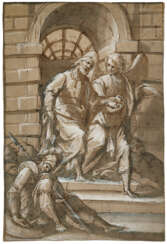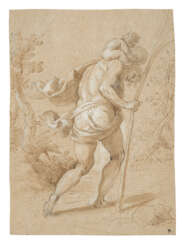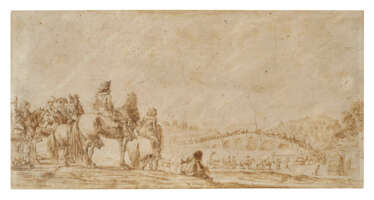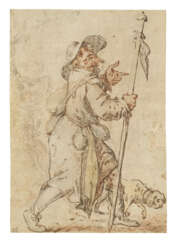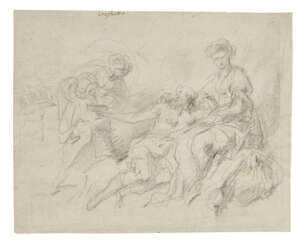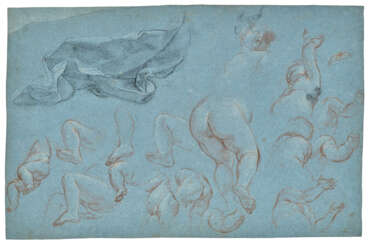
Old Master & British Drawings
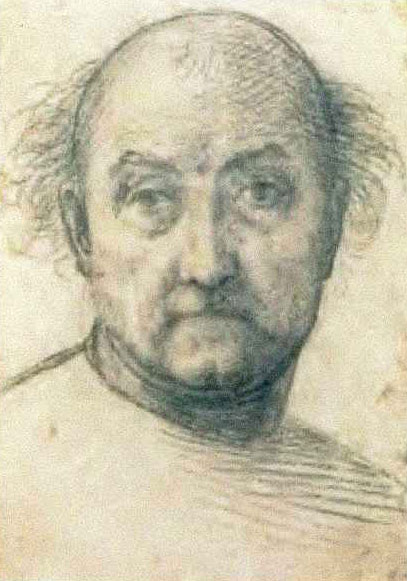
Fra Bartolomeo was an Italian painter, a notable figure of the High Renaissance. Known for his religious artworks, Fra Bartolommeo's style was deeply influenced by his spiritual journey and association with the Dominican Order.
After receiving his early artistic training from Cosimo Rosselli, Bartolommeo's style initially exhibited influences from artists like Piero di Cosimo, Domenico Ghirlandaio, and Filippino Lippi. However, his encounter with Savonarola, a Dominican friar and reformer, in the late 1490s led to a significant spiritual transformation. This encounter influenced him to enter the Dominican monastery at San Domenico in Prato as a novice in 1500, and he temporarily renounced painting. It wasn't until 1504, when he resumed painting as the head of the monastery workshop, that his style saw a significant transformation.
In his works, Fra Bartolomeo beautifully integrated the styles of Leonardo da Vinci and Raphael, especially in his altarpieces, which are imbued with a sense of pietism reminiscent of Fra Angelico. His work is notable for the skilled massing of light and shade, richness in coloring, and delicate handling of drapery. The introduction and use of the lay-figure with joints in his compositions were innovations he is credited with. His masterpiece, St. Mark Evangelist, and the undraped figure of Saint Sebastian, are particularly noted for their expressive power.
Some of his notable works include "Vision of St. Bernard" (1507), "The Holy Family with John the Baptist," and "Virgin and Child with Saints." His art can be found in prestigious galleries, including the Pinacoteca Vaticana, Palazzo Pitti in Florence, and the National Gallery in London.
For art collectors and enthusiasts, Fra Bartolomeo's works represent a blend of spiritual depth and artistic innovation during the pinnacle of the Renaissance period. His legacy in religious art continues to inspire and captivate audiences worldwide.
To stay informed about exhibitions and sales featuring works of Fra Bartolomeo, sign up for updates to explore more about this master's contributions to Renaissance art.

Parmigianino, an Italian Mannerist painter born Girolamo Francesco Maria Mazzola, was a pivotal figure in the development of the Mannerist style, known for his sophisticated and elegant approach to painting. He was a leading figure in Parma's art scene following Correggio and had a significant influence on the artistic developments during the post-High Renaissance period through his expressive and stylish works.
Parmigianino's journey as an artist took him from Parma to Rome and then to Bologna, with his last years spent in Parma. His works, including the renowned "Madonna with the Long Neck," display a unique blend of grace and elegance, coupled with an idiosyncratic use of elongation and distortion, typical of Mannerist aesthetics. This painting, in particular, is noted for its unusual composition and the elongation of figures, embodying the Mannerist style's departure from the proportional norms established during the Renaissance.
He was also an early Italian etcher, utilizing this technique to express the spontaneity of an artist's hand. His etchings and drawings had a considerable influence on printmaking and the visual arts in Italy and Europe. In addition to his paintings, Parmigianino's contributions to the arts include his work in the church of the Steccata in Parma and his innovative approach to integrating painting with architectural elements.
For art collectors and experts, Parmigianino's work represents a critical link between the High Renaissance and the emergence of Baroque and Rococo styles, offering a unique insight into the evolution of European art. His works continue to be celebrated for their originality and mastery, making him a subject of enduring interest in the study of art history.
For those interested in exploring Parmigianino's contributions to art further, subscribing to updates from art institutions or platforms specializing in Renaissance and Mannerist art could provide valuable insights into his life, works, and ongoing exhibitions or sales of his artworks.

Domenico Passignano, born Domenico Cresti or Crespi, was an Italian painter of a late-Renaissance or Counter-Maniera (Counter-Mannerism) style that emerged in Florence towards the end of the 16th century.

Giuseppe Cesari was an Italian Mannerist painter, also named Il Giuseppino and called Cavaliere d'Arpino, because he was created Cavaliere di Cristo by his patron Pope Clement VIII. He was much patronized in Rome by both Clement and Sixtus V. He was the chief of the studio in which Caravaggio trained upon the younger painter's arrival in Rome.

Iacopo Negretti, best known as Jacopo or Giacomo Palma il Giovane or simply Palma Giovane ("Young Palma"), was an Italian painter from Venice and a notable exponent of the Venetian school. After Tintoretto's death (1594), Palma became Venice's dominant artist perpetuating his style. Outside Venice, he received numerous commissions in the area of Bergamo, then part of the Venetian Domini di Terraferma, and in Central Europe, most prominently from the connoisseur emperor Rudolph II in Prague. Rejecting Mannerism in the 1580s, he embraced a reformist naturalism.[6] He varied the ingeniously synthesised amalgam according to subject matter and patrons' own eclectic and conservative tastes, with "virtuoso skill and a facile intelligence". Palma il Giovane went on to organize his own, large studio which he used to produce a repetitive series of religious and allegorical pictures that can be found throughout the territory of the Venetian Republic.
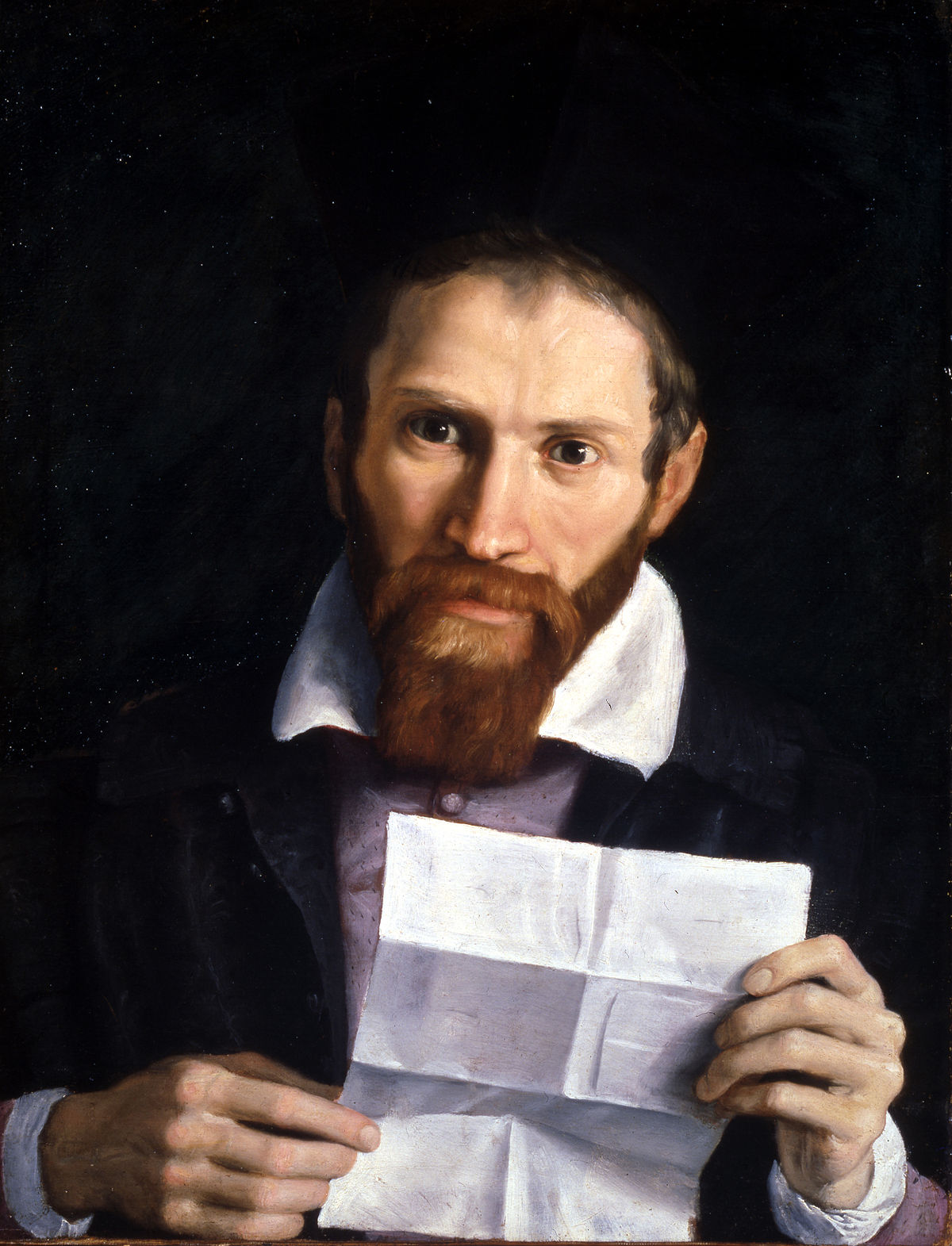
Domenico Zampieri, known as Domenichino, was an Italian Baroque painter who worked in Rome. He was a pupil of the Accademia Carracci in Bologna and was subsequently influenced by the works of Annibale Carracci and Caravaggio.
Domenichino was known for his use of vivid colours, dramatic lighting and his ability to convey emotion in his paintings. He was particularly adept at painting religious subjects and his works often depicted scenes from the life of Christ, the Virgin Mary and saints. He also participated in the fresco decoration of churches and several papal residences, and worked on the decoration of the Palazzo Barberini in Rome.

Giovanni Francesco Barbieri, better known as Guercino, was an Italian Baroque painter and draftsman from Cento in the Emilia region, who was active in Rome and Bologna. The vigorous naturalism of his early manner contrasts with the classical equilibrium of his later works. His many drawings are noted for their luminosity and lively style.

Giovanni Francesco Barbieri, better known as Guercino, was an Italian Baroque painter and draftsman from Cento in the Emilia region, who was active in Rome and Bologna. The vigorous naturalism of his early manner contrasts with the classical equilibrium of his later works. His many drawings are noted for their luminosity and lively style.

Giovanni Francesco Barbieri, better known as Guercino, was an Italian Baroque painter and draftsman from Cento in the Emilia region, who was active in Rome and Bologna. The vigorous naturalism of his early manner contrasts with the classical equilibrium of his later works. His many drawings are noted for their luminosity and lively style.

Antonio del Castillo y Saavedra was a Spanish Baroque painter, sculptor, and poet, renowned for his significant contributions to the Cordoba School of art. Born in Cordoba, Spain, in 1616, Castillo y Saavedra grew up under the influence of his father, Agustín del Castillo, also a painter. His early education continued under Ignacio Aedo Calderón, and later, in Seville, he studied with Francisco de Zurbarán and his uncle Juan del Castillo.
Castillo y Saavedra's work is distinguished by its adherence to naturalism, a style he maintained despite the evolving Baroque trends of his time. His landscapes and narrative paintings, often featuring elaborate architectural or landscape settings, showcase his unique spatial sense and meticulous studies of nature. Praised as an "excellent landscape painter" by his contemporaries, Castillo y Saavedra was adept at capturing nature's essence and integrating it seamlessly into his historical oil paintings. His works, such as the Calvary of the Inquisition and the series on the life of Joseph, exhibit a luminous sense of landscape with refined color palettes.
Some of his most celebrated works are housed in prestigious institutions around the world. The Museo del Prado in Madrid, Spain, holds an impressive collection of his paintings, including the notable series on the story of Joseph. The Museo de Bellas Artes de Córdoba also features his significant works, like the Calvary of the Inquisition.
Despite his death in 1668, Castillo y Saavedra's legacy lives on through his contributions to the Cordoba School, influencing generations of artists who followed. His work remains a testament to the rich cultural heritage and artistic prowess of the Spanish Golden Age.
For collectors and experts in art and antiques, Antonio del Castillo y Saavedra's works represent a pinnacle of Baroque art. To stay informed about new sales and auction events related to Castillo y Saavedra's work, we invite you to sign up for our updates. This subscription will keep you at the forefront of the latest developments in this fascinating field.

Salvator Rosa was a seventeenth-century Italian Baroque painter. He is also known as an engraver, poet and actor.
Salvator Rosa left a very diverse artistic heritage. He was interested in historical, religious, mythological and fantastic subjects, he painted landscapes, battle scenes, portraits, still lifes. Having joined the naturalists of the Neapolitan school of painting, Rosa, however, showed originality in his treatment of subjects. For example, in his paintings on historical themes he combined realistic images with fantastical composition.
The biography of Rosa himself, full of adventures, subsequently became the subject of legends, books, paintings and musical works.
Works of Salvator Rosa today are represented in many museums and private collections in Europe and Russia.

Giovanni Benedetto Castiglione or Il Grechetto was an Italian Baroque painter, draftsman and printmaker.
He is one of the prominent representatives of the Genoese school, working at various times in Genoa, Venice and Rome. Castiglione is believed to be the author of monotype, a type of graphic art and a technique of printmaking that is not engraving.
Castiglione was a versatile and prolific painter, while working in a wide variety of styles that he studied carefully. His paintings pay tribute to Rubens, Van Dyck and Bernardo Strozzi, who worked in Genoa, and his etchings pay tribute to Rembrandt. Castiglione painted expressive portraits, historical and religious works and landscapes, and excelled in rural scenes with animals.
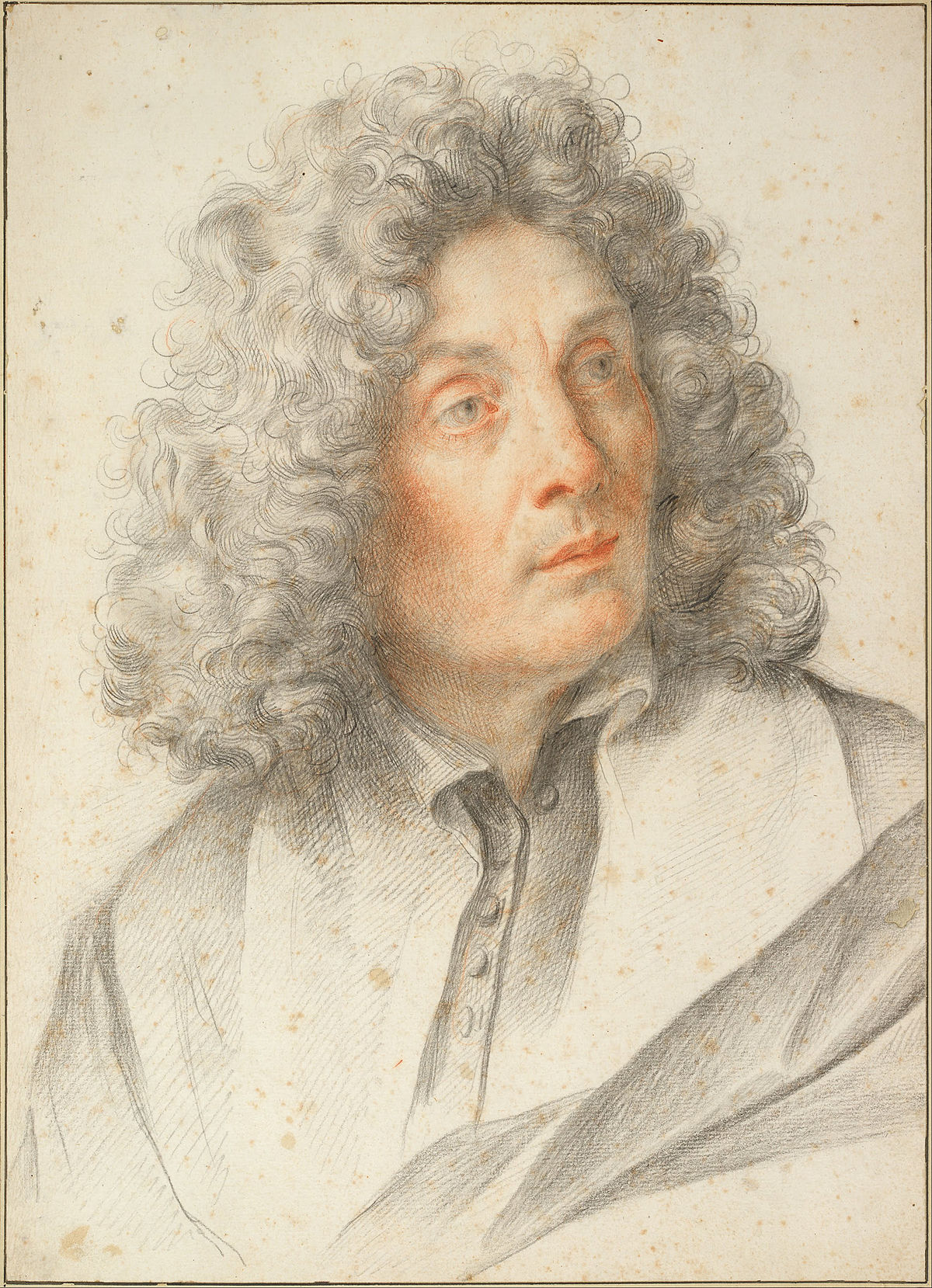
Carlo Maratta, an Italian painter, was a prominent figure in the Roman school of art during the late 17th century. Known for his classical approach to Baroque painting, Carlo Maratta's works were deeply influenced by the styles of Raphael and Andrea Sacchi, blending classical grandeur with Baroque expressivity. His training under Sacchi and subsequent exposure to Pietro da Cortona's coloristic style significantly shaped his artistic development.
Carlo Maratta's career flourished with a series of public and official commissions, making him a leading painter in Rome, especially after Bernini's death in 1682. His portfolio includes religious paintings, altarpieces, portraits, and fresco cycles, with a notable emphasis on paintings of the Madonna and Child, which reinterpreted High Renaissance motifs. His work was highly esteemed across Europe, influencing not only Italian art but also attracting the attention of English visitors on the Grand Tour.
One of Carlo Maratta's significant contributions to the art world was his involvement in painting restoration towards the end of his career, including works by Raphael and Carracci. This phase underscored his deep connection to the classical art tradition. Maratta passed away in Rome in 1713, leaving behind a legacy that continued to be celebrated in art history.
For art enthusiasts, collectors, and experts, Carlo Maratta's work offers a window into the transition between the Baroque and the emerging Rococo style, embodying a blend of dynamism and classical restraint. His paintings, many of which remain in situ in Roman churches, offer a testament to his enduring influence on Baroque classicism.
To stay updated on exhibitions and insights into Carlo Maratta's works, art aficionados are encouraged to subscribe for updates, ensuring access to the latest research and opportunities to view his celebrated works in museums and galleries around the world.



























